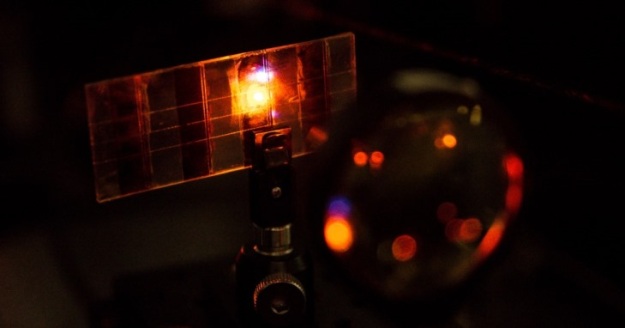Scientists at Nanyang Technological University (NTY) are claiming to have discovered a next-gen solar cell material that not only can convert light to electricity, but emit light too.

The discovery happened by chance when NTY physicist Sum Tze Chien asked his postdoctoral researcher Xing Guichuan to shine a laser on a new hybrid solar cell they were working on that was made from the material perovskite.
The solar cell glowed brightly, much to the team’s surprise, as this technology is known to be better at absorbing light rather than generating it.
“What we have discovered is that because it is a high-quality material, and very durable under light exposure, it can capture light particles and convert them to electricity, or vice versa,” said Assistant Professor Sum, a Singaporean scientist at NTU’s School of Physical and Mathematical Sciences (SPMS).
Worth noting: The light can also change colors.
“By tuning the composition of the material, we can make it emit a wide range of colors, which also makes it suitable as a light-emitting device, such as flat-screen displays,” Sum added.
The team expects the new material to be easily incorporated into existing technologies like smartphones, tablets, outdoor displays, and more.
“What we have now is a solar cell material that can be made semi-translucent. It can be used as tinted glass to replace current windows, yet it is able to generate electricity from sunlight,” said Sum’s research partner, Assistant Professor Nripan Mathews, from the School of Materials Science and Engineering (MSE) and the Energy Research Institute at NTU (ERI@N).
“The fact that it can also emit light makes it useful as light decorations or displays for the facades of shopping malls and offices,” said Dr. Mathews, who is also the Singapore R&D Director of the Singapore-Berkeley Research Initiative for Sustainable Energy (SinBeRISE) NRF CREATE program.
“Such a versatile yet low-cost material would be a boon for green buildings. Since we are already working on the scaling up of these materials for large-scale solar cells, it is pretty straightforward to modify the procedures to fabricate light-emitting devices as well. More significantly, the ability of this material to lase has implications for on-chip electronic devices that source, detect and control light,” he added.
There is a great deal of promise with this technology, according to Professor Ramamoorthy Ramesh, the Purnendu Chatterjee Endowed Chair in Energy Technologies professor at the University of California, Berkeley: “This work from the NTU SinBeRISE team clearly shows the promise of such new materials in a broad range of applications, including solar cells and now for lasing. It also shows the power of interdisciplinary, basic science in making fundamental discoveries that will impact in a broad sense.”
Another important consideration is the fact that this advanced material, still patent pending, is roughly five times cheaper than most of today’s silicon-based solar cells. This is due in large part to the fact that it comes with such a simple, solutions-based manufacturing process (it works by combining two or more chemicals at room temperature).
The group’s work was published in the journal Nature Materials , downloadable for a fee.
Story via ntu.edu.sg
Advertisement






